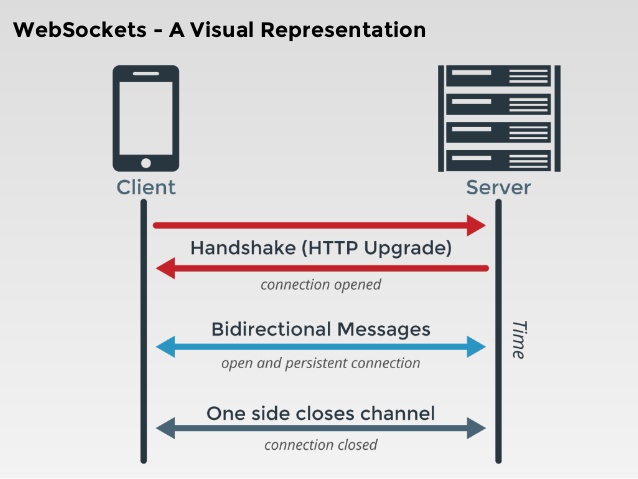What’s a WebSocket?
A WebSocket may be a low-latency (real-time), full-duplex (bidirectional), long-running (persistent), single connection (TCP) between a client and server. WebSockets provide an enormous benefit for real-time, event-driven web applications. it’s used for real-time data updates and synchronization, live text chat, video conferencing, VOIP, IoT control and monitoring. These capabilities enable apps in gaming, social networks, logistics, finance and residential , vehicle and industrial automation, to call a couple of . Most major web browsers currently support their use.
WebSockets are a bi-directional, fullduplex, persistent connections from a client to a server. Once a WebSocket connection is established the connection stays open until the client or server decides to shut this connection.
With this open connection, the client or server can send a message at any given time to the opposite . This makes web programming entirely event driven, not (just) user initiated.
WebSockets for IOT:
Given the necessity for visualizing lot of details on web dashboards in real time. Advent of cloud platforms for IOT etc. WebSockets would be a ideal choice for having lightweight communication between server and client.
A typical home IOT environment:
You could be having lot of devices at your home which needed to be visualized and controlled once you are faraway from your home otherwise you might be lazy getting up from your couch to show off something otherwise you want your grandparents to possess complete control of your home at their fingers then on.
In a typical gateway based IOT architecture, your gateway is usually connected to your server to ascertain the present status of devices over the web . Your server can send commands back to the gateway as long as there’s a two way communication. Doing an equivalent thing over http will involve your gateway constantly polling for commands from server. WebSockets makes your life easier.
Let’s say you wanted to supply your IOT system for all the residents of your apartment as a service. WebSocket would be a right choice in maintaining only one connection per gateway per flat. Otherwise, using http, your server are going to be flooded with lot of connections and disconnections for each poll per gateway per flat quite the data/commands to be sent across.
Real-time audio streaming environment:
We have built an application that permits people within a wifi network to speak from their mobile browser. this needs a true low latency audio streaming from the browser itself. WebSockets is useful here because it needed binary data streaming in real-time. employing a traditional HTTP for every and each frame would impact latency because it makes and breaks the connection for every and each frame, WebSockets on the opposite hand makes connection once and streams data thereon connection continuously. Also, an equivalent WebSocket are often wont to push messages, notifications and even transpired string asynchronously to all or any the clients from the server.
A self driving car, pizza delivery service, realtime ambulance guiding system to accident spot etc. There are many usecase where websockets are often or are going to be or getting used . See if your next usecase needs a WebSocket.
Protocol handshake
To establish a WebSocket connection, the client sends a WebSocket handshake request, that the server returns a WebSocket handshake response, as shown within the example below.
Client request (just like in HTTP, each line ends with \r\n and there must be an additional blank line at the end):
GET /chat HTTP/1.1
Host: server.example.com
Upgrade: websocket
Connection: Upgrade
Sec-WebSocket-Key: m20JJHMbDL1EzL4rthGBhXDw==
Sec-WebSocket-Protocol: chat, superchat
Sec-WebSocket-Version: 13
Origin: http://example.com
Server response:
HTTP/1.1 101 Switching Protocols
Upgrade: websocket
Connection: Upgrade
Sec-WebSocket-Accept: ASmrc0sMlYUkArty5OPpG2HaGWk=
Sec-WebSocket-Protocol: chat
The handshake starts with an HTTP request/response, allowing servers to handle HTTP connections also as WebSocket connections on an equivalent port. Once the connection is established, communication switches to a bidirectional binary protocol which doesn’t conform to the HTTP protocol.
In addition to Upgrade headers, the client sends a Sec-WebSocket-Key header containing base64-encoded random bytes, and therefore the server replies with a hash of the key within the Sec-WebSocket-Accept header. this is often intended to stop a caching proxy from re-sending a previous WebSocket conversation,[34] and doesn’t provide any authentication, privacy, or integrity. The hashing function appends the fixed string 258EAFA5-E914-47DA-95CA-C5AB0DC85B11 (a UUID) to the worth from Sec-WebSocket-Key header (which isn’t decoded from base64), applies the SHA-1 hashing function, and encodes the result using base64.
Once the connection is established, the client and server can send WebSocket data or text frames back and forth in full-duplex mode. the info is minimally framed, with a little header followed by a payload.WebSocket transmissions are described as “messages”, where one message can optionally be split across several data frames. this will leave sending of messages where initial data is out there but the entire length of the message is unknown (it sends one data frame after another until the top is reached and marked with the FIN bit). With extensions to the protocol, this will even be used for multiplexing several streams simultaneously (for instance to avoid monopolizing the use of a socket for one large payload).
The WebSocket protocol defines a ws:// and wss:// prefix to point a WebSocket and a WebSocket Secure connection, respectively.
—


